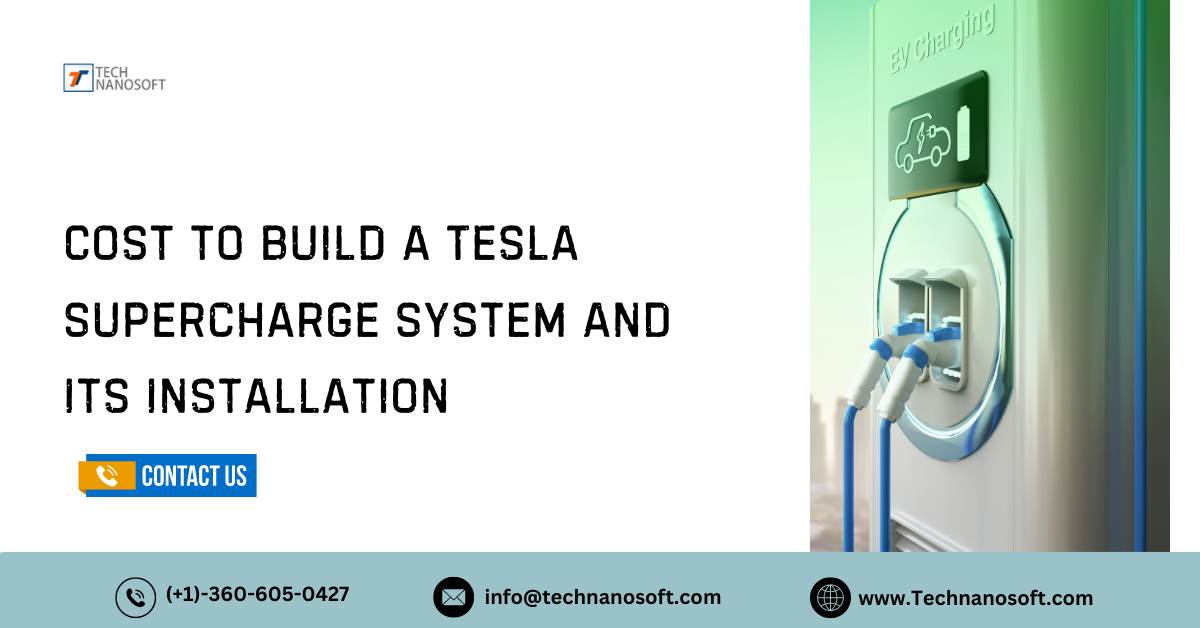Cost to Build a Tesla Supercharge System and Its Installation
In this modern world, chances are you must have at least heard of Cloud Computing, if not used it unknowingly. Cloud Computing is often referred to as internet-based computing, as the user can access their data anywhere, anytime, with internet access, instead of their computer's hard drive. A few examples of Cloud Computing are Amazon Web Services, Microsoft Azure, Google Cloud, Salesforce, and such applications. But what exactly are cloud computing resources? While the examples gave you some idea of what they do, Do you not wish to understand what else they offer, their characteristics that are considered essential?

When you start to use electric cars, you can enter the exciting world of Tesla supercharging. Tesla Supercharging plays a crucial role in quickly and efficiently charging EVs. Electric car travel by figuring out how Tesla Supercharging works. Finding nearby Supercharger sites and determining how long and how much does supercharging cost.
you can do in the Tesla Supercharging ecosystem. In this informative guide, we'll talk about how Tesla Supercharging has changed over time, how to find nearby Superchargers, charging times, different charging levels, prices, and valuable tips for getting the most out of your Tesla driving adventures. Join us on this exciting trip into Tesla's electric world.
How To Make an EV Charging System Like Tesla Supercharger?
Project Scope
Setting goals, outputs, and deadlines is essential to making a detailed plan for an EV charging system like Tesla Supercharge. This plan encompasses selecting a location, determining the necessary technology, and strategizing stakeholder involvement.
It provides a precise guide for executing the project. The project ensures rapid progress and alignment with the primary goals by meticulously outlining the necessary work. This leads to a successful implementation and happy stakeholders.
Create Wireframes and Mockups
Making wireframes and models for the EV charging system's user interface means making visual plans that show how things will look and work. These pictures are the basis for user input and iterative design improvements, which make the site easier to use and improve the user experience.
Users can easily connect with the charging system through interfaces that look good. This makes it easier to get to important features and increases user engagement.
Develop Server-side Logic and Database Architecture
Creating server-side solid logic and database design is part of setting up the backend infrastructure for the EV charging system. This includes making algorithms and data models that can handle user accounts, charging session data, and station status data in a good way. Using scalable and efficient backend systems ensures reliable performance and seamless user interactions. This makes it possible to handle high traffic volumes and improves business efficiency.
Develop Mechanisms for Real-time Monitoring
To create real-time monitoring charging stations, use monitors and telemetry systems to collect data on the charging session duration, power consumption, and station availability. Real-time monitoring allows operators to make the most of their stations and provide preventative maintenance assistance, which improves operational efficiency and user satisfaction. Real-time monitoring makes it easier to handle the charging network efficiently, which leads to a smooth user experience and long-term system operation.
Integrated Payment Gateways
Users can easily make purchases when the EV charging system incorporates safe payment gateways. By accepting various payment methods, including credit cards, mobile apps, and RFID cards, the charging network gets more users and makes money to keep running. Users will find it easier to use services that let them pay for things without any problems. This will lead to more people buying electric cars, and the charging network will grow, ultimately making the transportation ecosystem more sustainable.
Secure Data Transmission with Encryption Protocols
Encryption ensures that data sent between users, charging stations, and backend servers is safe. Industry-standard SSL/TLS protocols and encryption algorithms safeguard private data from hackers and unauthorized access. This improves data security and user trust. Data security is a top priority for following privacy laws and maintaining the charging system's purity, which leads to a reliable and trustworthy user experience.
Testing and Quality Assurance
To ensure that the EV charging system works and is reliable, it must go through strict testing and quality assurance processes. Unit, integration, and system testing can help you find and fix problems, ensuring the user experience is smooth. Prioritizing quality assurance lowers system failure risks, improving user satisfaction and protecting the charging network's integrity. This leads to a more stable and long-lasting infrastructure for electric car adoption.
Design Systems with Scalability
Scalability means building the EV charging system with scalable designs and cloud-based solutions to grow and expand in the future. By planning for scalability, the charging network can adapt to changing market conditions and help many people buy electric cars. This ensures that the system stays adaptable and can meet rising demand. This supports long-term growth and success, leading to a better and easier-to-reach charging infrastructure for electric vehicles.
READ ALSO- Spotify Stats Demo To Gain Valuable Insights
3 Levels of Charging Capabilities
Level 1
If you want to charge an electric car (EV) using a regular wall outlet, you can use level 1 charging. This type offers the slowest charging speed, typically providing 2 to 5 miles of range per hour. Level 1 charging is helpful for occasional use but is sluggish, so it might not work for EV owners who need to charge their cars often. It doesn't require additional tools besides the charging cable that comes with the car, so most EV owners can use it without spending much on infrastructure.
Level 2
Level 2 charging is faster than Level 1 charging, so many homes and businesses choose it for their charging stations. It works with a 240-volt AC power source and can give the vehicle between 10 and 60 miles of range per hour of charging, depending on the battery's size and charging abilities. Installing Level 2 chargers requires special tools like a charging station and a compatible plug or connector.
Although Level 2 charging is slower than DC fast charging, you can use it to charge devices overnight at home, for extended stays at work, or at public charging stations.
Fast Charging with DC
The fastest method for charging an electric car is DC fast charging, also known as Level 3 charging. This makes it ideal for long trips and quick toppings. DC fast chargers send direct current (DC) power directly to the car's battery, skipping the onboard charger. Level 1 and Level 2 chargers use alternating current (AC).
This makes charging possible; based on the charger's power output and the vehicle's battery capacity, this can add 60 to 250 miles to the range in just 20 to 30 minutes. You can find many DC fast chargers along the roads.
How Much Does it Cost to Create Software For Tesla Supercharger?
Tricky Algorithms
The Tesla Superchargers use complex algorithms to maintain network stability, enhance charging speeds, and ensure equal energy flow between sites. We carefully created these algorithms to provide efficient power distribution, ensuring quick and reliable charging for electric cars. It takes much knowledge in software engineering and electric vehicle technology to create and use such complicated algorithms. This adds to the total cost of software development for Tesla's charging infrastructure.
User Interface and Security
We are developing Tesla Supercharger software with an easy-to-use interface to ensure smooth charging and robust security measures to safeguard deals and user data. Strong security protocols protect privacy and trust, while easy-to-use app interfaces make apps more functional and increase user happiness. Adding biometric authentication and encrypted communication makes the software development process more difficult, which raises the total cost of supercharger installation.
Real-time Monitoring and Diagnostics
The Tesla Supercharger software provides tools to diagnose issues and monitor the station's performance in real time. Advanced software features allow for constant monitoring of charging sessions, troubleshooting from afar, and planned repair, making the network more reliable. Putting complex diagnostic tools and monitoring systems in place takes a lot of development work, which is why Tesla spends so much on software development for its charging infrastructure.
How can I Find Tesla Supercharger Near Me?
Explore Tesla's Official Website
Visit Tesla's website and use their live Supercharger map to find nearest tesla charging station. You can type in your location or look around the map to see which Supercharger stations are close, how many are available right now, and how fast they charge. This easy-to-use tool gives you full details about each charging station, such as amenities and nearby sites, so you can easily plan your stops while you're traveling.
Use Tesla's Mobile App
You can learn more about tesla store near me superchargers by downloading the Tesla app for iOS or Android devices. The app has a built-in map feature that shows where nearby Superchargers are, how available they are right now, and how long it will take to charge. You can also get alerts and information about your charging session from the app, so you can charge without any problems wherever you are.
Check Navigation Systems
Many Tesla cars have built-in navigation systems that show you where Supercharger stations are along your trip. Just tell the navigation system where you want to go, and it will take you through Supercharger stations as needed to make the most of your trip time and charging stops. During long trips, this built-in function makes it easy to get to Superchargers and gives you real-time directions.
Use Apps and Websites From other Companies
You can use several third-party apps and websites to find Superchargers near you. These sites collect information from Tesla's official sources and add extra features like photos, user reviews, and charging data. PlugShare, ChargePoint, and A Better Routeplanner are some of the most popular apps that help you confidently plan your charging stops. They give you detailed information about where Superchargers are located and what services they offer.
Ask Tesla Owners Community
Talk to other Tesla users in online communities, social media groups, and forums to get suggestions on how to find Superchargers near you. Tesla fans are often eager to share their thoughts and experiences, such as their best places to charge and discover hidden gems. Using what other Tesla users know, you can find new Supercharger stations and make better plans for your charging routes, improving your driving experience.
How Long Does it Take to Charge a Tesla with a Supercharger?
Charging Time with Supercharger
How long it takes to charge a Tesla with a Supercharger varies on several things, such as the size of the battery, the current charge level, and the power output of the Supercharger. Usually, it takes 15 to 20 minutes for a Tesla to gain up to 200 miles of range at a Supercharger station. However, the exact charge time may differ depending on these things and the type of Tesla. Superchargers, designed to charge quickly and efficiently, are ideal for long drives and reduce downtime during driving.
Battery Size and Charging Speed
How long it takes to charge at a supercharger depends a lot on the size of the Tesla's battery pack. It may take longer to charge cars with larger batteries, such as the Model S Long Range or Model X Long Range, than to charge vehicles with smaller batteries, such as the Model 3 Standard Range. The Supercharger's power level is also a significant factor in determining how fast the car charges.
The newest V3 Superchargers from Tesla can provide peak charging rates of up to 250 kW, significantly reducing the time it takes to charge compatible cars.
Charging Efficiency and Range
Tesla's Supercharger network employs cutting-edge technology to make charging efficient and get the most range out of each charging session. With high-power chargers and intelligent energy management systems, Tesla cars can quickly recharge their batteries and increase their range with little to no wait time.
This lets Tesla owners rapidly charge their vehicles on long trips so they can take shorter breaks and move more quickly. Tesla drivers can easily access fast and reliable charging infrastructure anywhere in the world thanks to the careful placement of Superchargers along major highways and popular routes.
Planning Charging Stops
When making a trip with a Tesla, it's essential to consider where you can charge it so that you have enough range and don't have to wait too long. Tesla's navigation system considers Supercharger sites and charging times when planning your trip, giving you real-time directions and suggestions for the best places to stop and charge. To make your trip experience easier and get the most out of your Tesla's Supercharger, follow these tips and plan your charging sessions ahead of time.
How Much Does a Supercharger Cost?
Tesla Superchargers
Tesla Superchargers are the best way to charge an electric car, and they offer Tesla users unparalleled convenience and efficiency. Tesla carefully places these high-powered charging stations along the world's busiest travel routes.
This makes long trips easier without having to worry about range limits. Tesla Superchargers can fully charge a vehicle's battery in a concise amount of time thanks to their ultra-fast charging technology. This has fundamentally transformed the charging process for electric cars.
Using cutting-edge technology and new design, Tesla Superchargers show the company's dedication to environmentally friendly transportation and customer happiness, providing an appealing answer to the difficulties of EV adoption. The Tesla Supercharger network is still the best for charging electric cars, and it will continue to shape the future of car travel as it grows and gets better.
Variable Costs by Location
tesla supercharger price rates for superchargers vary from place to place because of things like energy rates, government rules, and investments in infrastructure. The cost of charging at a Tesla Supercharger station typically depends on the energy consumption, tesla supercharger price per kwh. This pricing model considers how much energy is required in the area and how much it costs to run the Supercharger network.
Some areas may have relatively lower energy rates, while others may have higher costs due to changes in demand and the construction of new infrastructure. Knowing that the cost of using a supercharger varies depending on where you are lets Tesla owners make intelligent choices about how to charge and how much to spend, making the charging experience more efficient and affordable.
Average Cost Range
At a Tesla Supercharger, the average charging cost stays within a predictable range. This gives users confidence and certainty. Prices may change a little based on where you live and when you use the electricity, but as a rough guide, it costs about $0.25 per kilowatt-hour (kWh). Supercharging is more cost-effective than regular gas stations, particularly for long trips where speed and convenience are crucial.
Even though Tesla Superchargers cost more than home charging, they are still a good choice for Tesla owners who want to charge their cars quickly and reliably without spending much money.
Cost Estimation
To determine how much a Tesla Supercharger charging session will cost, you must consider several factors, including the size of the vehicle's battery and the amount of charge you want. Users can get a rough idea of how much their charging session will cost by increasing the battery's capacity in kilowatt-hours (kWh) by the cost per kWh. For instance, it might cost about $13.75 to charge a 75-kWh battery from 10% to 80% capacity at a rate of $0.25 per kWh. Tesla owners can use this estimation me
thod to plan their charging stops and budget their charging costs more effectively, making owning an electric car more efficient and affordable.
How can Technanosoft assist you in developing your EV charging software?
Technanosoft has all the tools you need to create EV charging software that works perfectly and is easy to integrate. Specializes in creating custom software that meets the needs of electric vehicle charging facilities. They do this using cutting-edge technology and years of field experience. Technanosoft offers scalable and practical solutions that make charging more accessible and improve the user experience.
These solutions include user-friendly displays and robust backend systems. Technanosoft focuses on innovation and dependability to assist companies in starting and growing in the electric vehicle market. This helps move forward with sustainable transportation projects and meet the changing needs of modern mobility.
FAQs on EV Tesla Charging
Q.1- How long does it take to charge a Tesla at a super charged?
A- Charging times depend on things like the size of the battery and how charged it is right now. Most Tesla Superchargers can add up to 200 miles to a car's range in 15 to 20 minutes. This makes them great for quick charges while on long trips.
Q.2- How much does it cost to charge a Tesla at a Supercharger?
A- Supercharger prices change based on where and how many tesla supercharger cost per kwh you use. You can expect to pay about $0.25 per kWh. Supercharging is a faster way to recharge that is more handy for traveling but costs a little more than charging at home.
Q.3- Where can I find Tesla Superchargers?
A- Tesla's website and mobile app have live maps showing where Supercharger stations are located. Supercharger stations are conveniently located along highways, urban areas, and popular routes.
Q.4- Can I charge my non-Tesla electric vehicle at a Tesla Supercharger?
A- Only Tesla cars can use Tesla Superchargers; other EVs cannot. However, public charging networks such as Electrify America offer choices for various EV types.
Q.5- Is there more than one kind of Tesla Supercharger?
A- Tesla does have V2 and V3 superchargers. V3 chargers can charge at speeds up to 250 kW, whereas V2 chargers can only charge around 150 kW at most.









